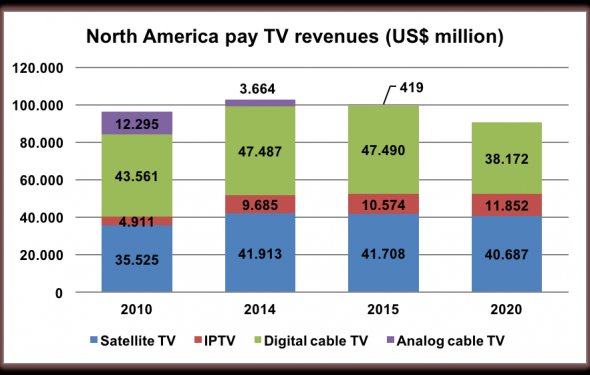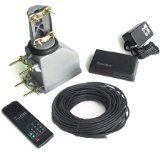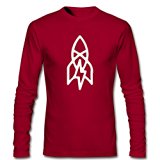American cable television and satellite television channels

A cable television headend is a master facility for receiving television signals for processing and distribution over a cable television system. The headend facility is normally unstaffed and surrounded by some type of security fencing and is typically a building or large shed housing electronic equipment used to receive and re-transmit video over the local cable infrastructure. One can also find head ends in power line communication (PLC) substations and Internet communications networks.
Reception[edit]
Most cable TV systems also carry local over-the-air television stations for distribution. Since each terrestrial channel represents a defined frequency, a dedicated commercial-grade receiving antenna is needed for each channel that the cable company wishes to receive and distribute. Smaller systems may use a broadband antenna to share several channels. These antenna are often built into a single tower structure called a master antenna television structure. Commercial TV pre-amplifiers strengthen the weakened terrestrial TV signals for distribution.
Some cable TV systems receive the local television stations' programming by dedicated coaxial, microwave link or fiber-optic line, installed between the local station and the headend. A device called a modulator at the local station's facilities feed their programming over this line to the cable TV headend, which in turn receives it with another device called a demodulator. It is then distributed through the cable TV headend to subscribers. This is usually more reliable than receiving the local stations' broadcasts over the air with an antenna. However, off-air reception is used as a backup by the headend in case of failure. In some cases systems receive local channels by satellite.
Other sources of programming include those delivered via fiber optics, telephone wires, the Internet, microwave towers and local public-access television channels that are sent to the cable headend on an upstream frequency over the cable system itself (known in the industry as "T"-channels), or via a dedicated line set up by the cable company, as mentioned earlier for reception of local television stations' programming by the headend.
Signal processing[edit]
A standard rack mount headend
Once a television signal is received, it must be processed. For digital satellite TV signals, a dedicated commercial satellite receiver such as a GI DSR4400X or a Scientific Atlanta/PowerVu satellite receiver is needed for each channel that is to be distributed by the cable system; these are usually rack-mountable receivers that are designed to take up less space than consumer receivers. They output video and stereo audio signals as well as a digital signal for digital plants.
Analog terrestrial TV signals require a processor which is a RF receiver that outputs video and audio. In some cases the processor will include a built-in modulator.
Digital terrestrial TV signals require a special digital processor.
Digital channels are usually received on an L band QAM stream from a satellite, which uses multiplexing. Using special receivers such as the Motorola MPS, the signal can be demultiplexed or "Demuxed" to extract specific channels from the multiplexed signal. At this point, local insertion may be performed to add content specifically targeted to the local geographic area.
Modulation[edit]
Cable television signals are then mixed in accordance with the cable system's channel numbering scheme using a series of cable modulators (one for each channel), which is in turn fed into a frequency multiplexer or signal combiner. The mixed signals are sent into a broadband amplifier, then sent into the cable system by the trunk line and continuously re-amplified as needed.
Modulators essentially take an input signal and attach it to a specific frequency. For example in North America, NTSC standards dictate that CH2 is a 6 MHz wide channel with its luminance carrier at 55.25 MHz, so the modulator for channel 2 will impose the appropriate input signal on to the 55.25 MHz frequency to be received by any TV tuned to Channel 2.
Digital channels are modulated as well; however, instead of each channel being modulated on to a specific frequency, multiple digital channels are modulated on to one specific NTSC frequency. Using QAM (Quadrature Amplitude Modulation), a CATV operator can place usually up to eight subchannels on each channel so channel 2 may actually be carrying channels 1 - 8 in a viewer's city. Set top boxes (STBs) or CableCards are required to receive these digital signals and are provided by the cable operator themselves.
Distribution plant[edit]
The plant consists of trunk lines that run from one distribution amplifier to the next. Feed lines run from a bridge amplifier inside the distribution amplifier to taps that are placed in front of a section of close together homes. From the taps a drop, consisting of a buried or aerial coax, runs to each home that wishes to obtain service. Unused ports on a tap are normally terminated with anti-theft terminators. To extend the feed lines even further line extenders are used which are small amplifiers. Small systems have been built without trunk lines using only line extenders every few thousand feet.

|
Channel Master 9521A Antenna Rotator & 50' Rotor Wire - TV HAM CB WIFI Rotor Speakers (Channel Master)
|

|
Jiuhe Men's Great Big Story Logo American Basic Cable and Satellite Television Channel Long Sleeve Cotton T Shirt Burgundy XXL Apparel
|